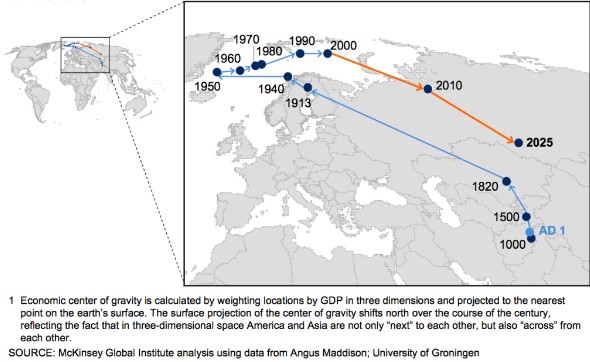I was given a review copy of No Ordinary Disruption: The Four Global Forces Breaking All the Trends, which I read over the weekend. The authors are Richard Dobbs, James Manyika, and Jonathan Woetzel — all directors at the McKinsey Global Institute.
Readers of this blog are not going to be surprised by some of the disruptions highlighted by this book, namely the enormous impact that emerging economies are having on global brands (and future global brands). In fact, I doubt readers will find any of these four disruptive forces to be unique.
But what’s unique is how the book ties these four major forces together in a book that’s packed with insights and anecdotes while remaining free of management-speak.
First, here are the four disruptive forces:
- The age of urbanization, creating massive new cities in emerging economies. By 2025, 48 of the largest 200 cities will be in China. This is resulting in a shift in the earth’s economic “center of gravity” back towards Asia. The center of gravity used to be centered over India and China and now it’s headed back again.
- Accelerating technological change. It used to take a very long time for a technology to reach “scale” — but now, driven in large part by mobile penetration of smartphones, an application can go from one to 500 million users in less than a year.
- Aging populations, placing a greater economic burden on fewer workers. China is a lot like the US in facing a future with fewer workers relative to the number of elderly.
- Greater (and more complex) interconnectedness. We’re all more tightly connected than ever before, which is nice if you want to sell your product anywhere in the world, but uncomfortable when you realize anyone else in the world is now a potential competitor.
Don’t expect this book to give you any concrete secrets about how to successfully navigate these forces — the authors rightfully point out that there are just too many variables at play to know exactly what this future world will look like.
What this book excels at is quickly summarizing these forces and the challenges they pose to businesses and policy makers. And using real-world examples to illustrate these forces.
I enjoyed the many visuals included in the book, such as this one, illustrating this shifting of the economic center of gravity:

From a web globalization perspective, a few parts of the book jumped out at me, such as:
- China’s ecommerce market is now the world’s largest. But this is just one country — globally, well more than a billion people will be joining the “consumer class” over the next decade. And they won’t be based in developed markets.
- The rise of emerging-market competitors are going to keep legacy multinationals on their toes. I would place Xiaomi in this group — a fast-moving Chinese company with global ambitions.
- When going global, you should focus on cities and urban centers, not regions or countries. I found this point to be among the most important takeaways for those managing web and product localization. If you consider just how complicated it is to market a product across the United States, with all the many ethnic groups, economic classes, geographic regions, age groups, etc. it’s only logical that you need to think similarly about other countries.
The authors want this book to help you “reset your intuitions” about the world as you know it. For instance, we can’t think of China as a country with two large cities. It’s a country with numerous cities that rival many European countries in population. And we need to be on the lookout for opportunities (and threats) in countries that we may have overlooked in years past. There are a number of African countries, for example, that Chinese companies are now heavily invested in. And companies are learning that products and distribution strategies that succeed in emerging economies often have little in common with what works in more developed economies. These lessons are important to learn earlier than later!
Perhaps the most important message the authors deliver is one of staying curious and adaptable.
These are traits that make successful managers of global websites. After all, we can’t know what’s around the corner with any degree of certainty. But by keeping a curious and open mind you will be prepared to ride these waves as they come along.


Comments are closed.